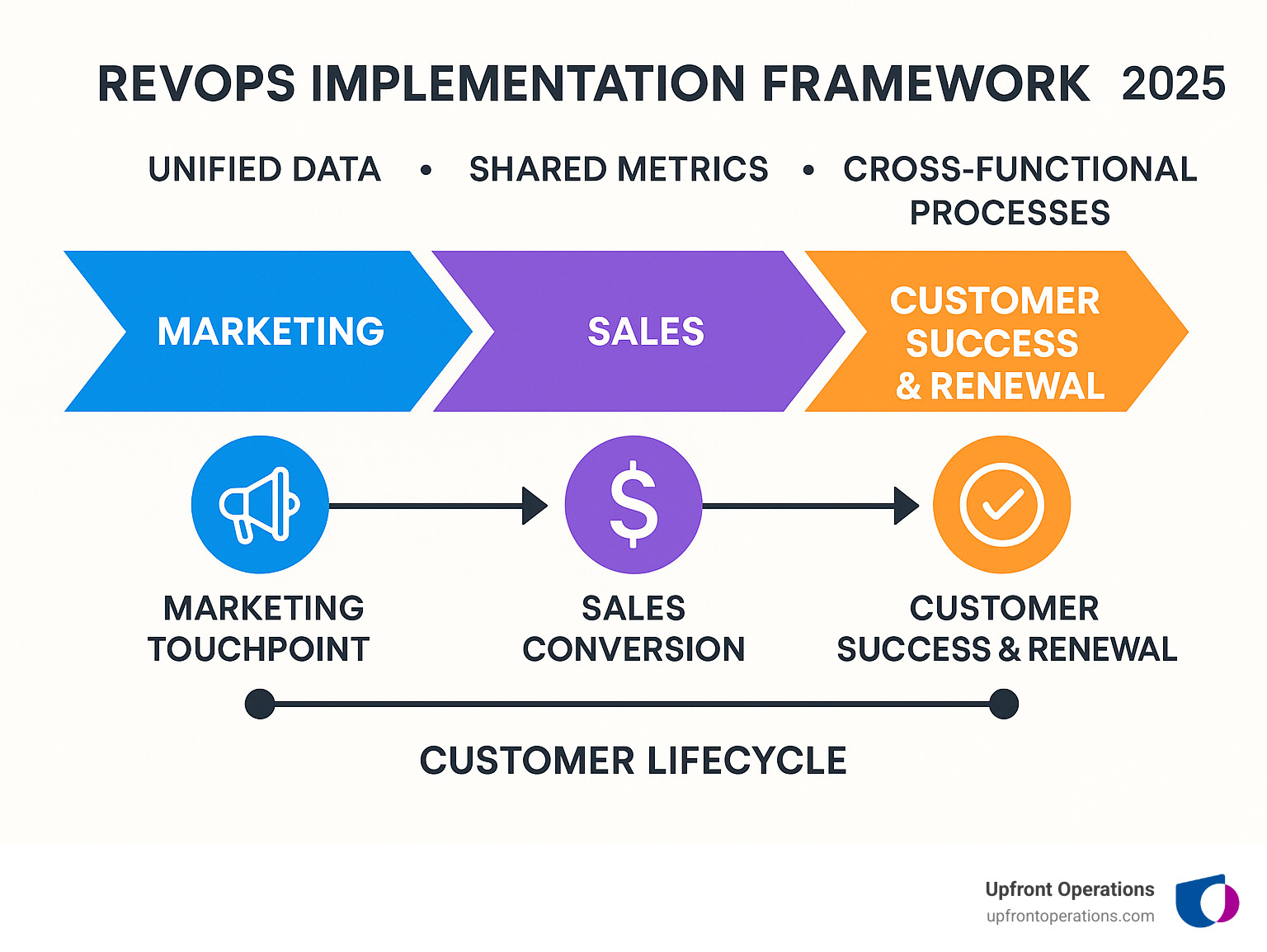The Road to Revenue: How to Implement RevOps
Learn how to master revops implementation. Align teams, optimize processes, and build predictable revenue with our step-by...
Learn how to master revops implementation. Align teams, optimize processes, and build predictable revenue with our step-by...

RevOps implementation has become the secret weapon for high-growth companies. By 2026, 75% of the highest-growth companies will adopt a RevOps model, aiming to break down departmental silos and create predictable revenue.
Quick Answer: RevOps Implementation Steps
The numbers don't lie: companies with mature RevOps are twice as likely to exceed revenue goals. Yet many businesses struggle with inconsistent sales processes, low lead conversion, and manual tasks that waste valuable time.
Traditional siloed approaches for sales, marketing, and customer success create costly friction. A single negative experience can lose 32% of customers. RevOps is the glue that aligns these teams around shared processes, data, and goals.
But how do you actually implement RevOps without disrupting operations? The key is a structured, phased approach that addresses foundational pillars while maintaining momentum.
I'm Ryan T. Murphy, founder of UpfrontOps. For over 12 years, I've helped companies implement RevOps strategies that cut waste, fix processes, and open up millions in revenue. My approach uses smart automation and clean data to scale businesses without chaos, often achieving 28% shorter sales cycles and 10X more qualified leads.

Revops implementation terms made easy:
Think of RevOps implementation like a home renovation: you need a plan before you start tearing down walls. Before diving in, honestly assess your starting point to build a realistic roadmap. Many companies jump into buying tools or restructuring teams, only to create more confusion.
A simple SWOT analysis (Strengths, Weaknesses, Opportunities, Threats) can help identify existing bottlenecks and prepare you to open up the real Benefits of RevOps. Knowing your current state also helps you communicate the "why" behind changes to your team.
RevOps is about getting marketing, sales, and customer success to work together. But change is hard, especially when it means sharing data. Do you have leadership buy-in? Without executive commitment to breaking down silos, your RevOps implementation will struggle. Leaders must champion cross-functional collaboration.
Look at your team structure. Are teams protective of their turf? Do they blame each other for lost deals? These are signs you need solid change management. When people see how RevOps makes their jobs easier—like giving sales better leads or helping marketing prove its impact—resistance fades.
You may also find skill gaps. Perhaps your sales team struggles with data analysis, or marketing ops doesn't understand the sales process. This is where on-demand expertise like a Sales Operations Analyst or Fractional RevOps can be a game-changer, providing immediate expertise without a full-time hire.
If your current workflows are a garbled mess, you're not alone. Most company processes evolve organically into a patchwork nobody fully understands. Start by mapping your entire customer journey, from first touchpoint to renewal. Where do leads get stuck? Where do customers get frustrated? These friction points are revenue killers.
Pay special attention to handoffs between teams, like when marketing passes a lead to sales. This is where information is often lost or incomplete. A poor handoff from sales to customer success can also ruin the customer experience. Don't forget your customer onboarding process; if it's inconsistent, you're setting customers up for failure. RevOps implementation forces you to standardize these critical processes. For expert help, on-demand services like Fix Inefficient Sales Processes or Create Client Onboarding Process can optimize workflows quickly.
Most companies are drowning in data but starving for insights. You likely have marketing, sales, and customer success data in separate systems, making it impossible to see the full picture. Start with a basic question: Can you trust your reports? If departments show different numbers for the same metrics, you have a data quality problem.
Data silos are another common issue. When each department guards its data, you can't see how marketing activities impact closed deals or how sales behavior affects retention. The goal is a single source of truth. CRM data integrity is especially critical. If reps don't trust the CRM, they won't use it, and your forecasts will be useless. On-demand solutions can help you Fix Messy Customer Data and Unify Sales Marketing Data without the long projects traditional consultants require.
Finally, audit your tech stack. Most growing companies have a collection of band-aid solutions rather than an integrated system. Integration gaps are the biggest culprit. When your marketing automation platform doesn't talk to your CRM, data is transferred manually, wasting time and creating errors. Tool redundancy is another problem; you might be paying for three tools that do the same thing.
The goal isn't one magic platform, but an integrated ecosystem where each tool has a clear purpose and shares data seamlessly. If you're overwhelmed, resources like How to Build a RevOps Tech Stack can guide you, while on-demand services that Fix Tech Stack Integration Issues can solve specific problems quickly. Assessing your readiness first prevents costly mistakes, showing you exactly where to focus your efforts for maximum impact.
Now that you've assessed your readiness, it's time to build your roadmap. RevOps implementation is a strategic change, not a single event. A structured plan prevents chaos and allows you to see progress at each milestone, building momentum. It's about creating a strong foundation, not achieving perfection on day one.
For deeper strategic insights, see our guides on How to Implement RevOps and building a robust Revenue Operations Strategy.
Every successful RevOps implementation starts with clear, measurable goals. "Increase revenue" is a wish; "reduce sales cycle length by 20% in six months" is a goal. Executive buy-in requires painting a picture of success for each department: marketing gets better leads, sales gets shorter cycles, and customer success gets smoother handoffs.
A RevOps charter formalizes this commitment, outlining the vision and responsibilities to keep everyone aligned. To build confidence, our on-demand services can help you Create Revenue Tracking System and Build Revenue Forecasting Models, giving executives the data they need to champion your initiative.
This is where the rubber meets the road. Map your customer journey from the first website visit to renewal. The magic happens when you standardize handoffs between teams, eliminating lost leads and conflicting information. A unified playbook creates consistency that customers can feel, building trust.
This foundation also enables closed-loop reporting, so you can finally answer, "Which marketing activities drive revenue?" Our experts can accelerate this step by helping you Create Full Funnel Visibility and Set up Closed Loop Reporting, turning guesswork into a science.
Your tech stack powers your RevOps implementation. The goal is to create a single source of truth, not just collect fancy tools. Your CRM should be the central hub, fed by all other systems. This gives sales a complete customer history, marketing clear attribution, and customer success the context they need.
| Tool Category | Purpose | Examples | Upfront Operations Services |
|---|---|---|---|
| CRM | Customer data management, sales pipeline | Salesforce, HubSpot CRM, Zoho CRM | CRM Integration for RevOps, Integrate HubSpot with Salesforce |
| Marketing Automation | Lead nurturing, email campaigns, analytics | HubSpot Marketing Hub, Pardot, Marketo | Create Automated Lead Nurturing |
| BI Tools | Data visualization, reporting, dashboards | Tableau, Power BI, Looker Studio | Create Custom Sales Dashboard |
| Integration Platforms | Connect systems, automate workflows | Zapier, Workato, Tray.io | Fix Tech Stack Integration Issues |
Think of data warehousing as a central library for customer information. Our team makes these integrations seamless, whether you need help with CRM Integration for RevOps or want to Integrate HubSpot with Salesforce.
Success comes down to the details. This checklist ensures every base is covered:
For strategic guidance, our Sales Operations and Planning Strategy provides a framework. And since tools are useless without adoption, our CRM Training: Open up Your Team's Full Potential with These Expert Tips ensures your team can leverage your investment.
Congratulations on launching your RevOps implementation! But this isn't the finish line; it's mile marker one. RevOps isn't a "set and forget" function. It's a living part of your business needing constant attention and optimization.
Think of it like a high-performance car that needs regular maintenance to perform at its peak. According to Gartner research on RevOps adoption, companies that continuously mature their RevOps functions see far better results. The secret is a continuous improvement mindset: a cycle of measuring, analyzing, optimizing, and iterating. This flywheel approach ensures your revenue engine runs smoothly.
If you're not measuring your RevOps implementation success, you're flying blind. RevOps metrics tell the story of your entire revenue engine.
The key is creating a data-driven culture where these metrics guide every decision. Our on-demand experts can help you Create Sales Performance Metrics that drive behavior change or Track Marketing ROI by Channel to optimize your budget.
Even the best RevOps implementation hits bumps. Anticipate these common challenges:
In a mature RevOps function, automation and AI are the turbo boost for your revenue engine.
The integration of RevOps Automation and AI in Sales Operations transforms your function into an intelligent, predictive revenue engine.
Let's address some of the most common questions I hear when companies are considering RevOps implementation. These questions come up in almost every conversation I have with business leaders who are ready to break down silos and create predictable revenue growth.
Think of Sales Ops as focusing on one piece of the puzzle (the sales team), while RevOps sees the whole picture. Sales Operations optimizes the sales funnel to help salespeople close deals faster.
RevOps implementation, however, aligns marketing, sales, and customer success across the entire customer lifecycle. Instead of separate silos, RevOps creates one unified revenue engine with shared goals, processes, and data. It's about driving accountability and predictable growth across the entire customer journey, from lead generation to retention.
This is probably the question I get asked most often, and the answer is "it depends" on your company's size, complexity, and maturity. A phased approach can show initial results like better data and cleaner handoffs in 3-6 months. However, building a truly mature RevOps function typically takes 12-24 months.
The good news? You don't have to wait to see value. Using on-demand microservices from Upfront Operations can significantly speed up specific stages. Instead of spending months integrating tools, an expert can do it in weeks, delivering value much faster.
For most companies starting their RevOps implementation, I recommend a RevOps Manager or a senior Sales Operations Analyst with experience beyond just sales. This person needs a broad understanding of marketing and customer success to act as your strategic architect, building foundational processes and fostering cross-functional alignment.
Finding someone with true RevOps experience can be challenging and expensive. Many companies find success starting with fractional RevOps support to build the foundation, then hiring full-time as they scale. This gives you experienced leadership without the immediate overhead.
RevOps implementation is a fundamental shift, not just another initiative. It transforms separate departments into a unified revenue engine. Imagine marketing, sales, and customer success working in perfect sync. That's the magic of RevOps: no more dropped leads, miscommunication, or frustrated customers.
Our guide provides a clear roadmap, but you don't have to do it all at once. Start with your biggest pain points, like fixing messy customer data or improving team handoffs. The numbers are clear: companies with mature RevOps are twice as likely to exceed revenue goals. More importantly, you gain the peace of mind that comes with predictable, sustainable growth.
Ready to accelerate your RevOps implementation but lack the internal team? Upfront Operations provides elite fractional sales operations experts and on-demand microservices to tackle specific challenges immediately. Whether you need to unify your sales and marketing data, create full funnel visibility, or set up closed loop reporting, we deliver targeted results without the overhead of agencies or freelancers.
RevOps is your path from revenue chaos to clarity. The only question is how quickly you can get started.